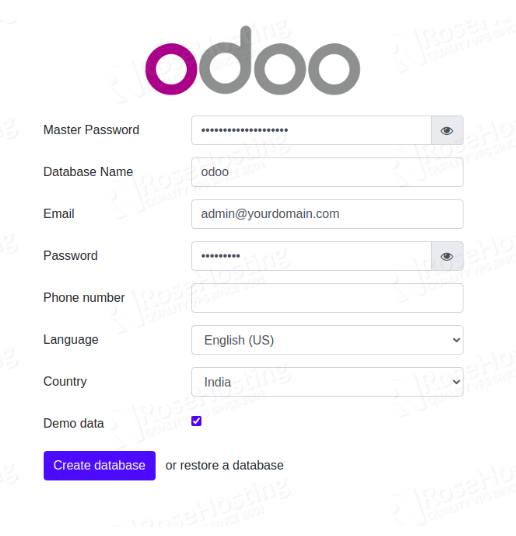This article will guide you through the installation and configuration process of Odoo 17 in a CentOS 7 system.
Prerequisites
OS: CentOS 7
Resources: 2-core CPU & 2GB of RAM
Access: SSH connection to the server
Permissions: a user with 'sudo' privileges
Note: you can execute all of the commands below from the root user, but for security purposes, it is recommended that you use a separate user with sudo privileges.
Step 1: Log in to the Linux server via SSH as the root user:
The first step in the installation is to connect to your server via ssh. You can log in to the server using ssh.
ssh username@IP_Address -p Port_number
e.g. ssh [email protected] -p 22Step 2: Update Packages and Install Python3.10
CentOS 7 comes with Python 2 by default. Odoo17 requires Python3.10. So we need to install the required version first.
Make sure your system is updated:
sudo yum updateInstall required dependencies:
sudo yum groupinstall "Development Tools"
sudo yum install wget readline-devel ncurses-devel openssl-devel sqlite-devel tk-devel gdbm-devel libc6-dev libbz2-dev libffi-dev zlib1g-dev
Download the archive from Python’s official site:
wget https://www.python.org/ftp/python/3.10.0/Python-3.10.0.tgzExtract the archive:
tar xzf Python-3.10.0.tgzMove to the extracted directory:
cd Python-3.10.0 Compile on your system
./configure --enable-optimizations Finally, install it on your system, make sure you are using altinstall command since this might replace your current Python version if you don’t use this command:
make altinstallIf that is successfully installed you can check the Python version:
python3.10 -V
or
python3.10 --versionStep 3: Create an Odoo user.
Create a new user called odoo17 with home directory /opt/odoo17. This prevents the security risks posed by running Odoo under the root user. You can do it with this command. You can give any name to the user. However, be careful to create a PostgreSQL user with the same name.
sudo useradd -m -d /opt/odoo17 -U -r -s /bin/bash odoo17Step 4: Install Dependencies
Since Odoo is built on Python, we need to install some dependencies to proceed with installing Odoo 17 on our CentOS 7. We can install them by running the commands below.
sudo yum install git python3-pip python3-devel libxml2-devel libxslt-devel zlib-devel libsasl2-devel libldap2-devel gcc-c++ libffi-devel openssl-devel mysql-devel libjpeg-devel postgresql nodejs
sudo npm install -g less less-plugin-clean-css
sudo yum install -y nodejs-lessStep 5: Install and configure PostgreSQL
In this step, you need to set up the database server. Odoo uses PostgreSQL as the database back-end. Install the database server for Odoo By using the following command.
sudo yum install postgresql-server
sudo postgresql-setup initdb
sudo systemctl start postgresql
sudo systemctl enable postgresqlNow you need to create a PostgreSQL user to handle the database server i.e. PostgreSQL. In our case, we will create a PostgreSQL user with the same name as the previously created system user i.e odoo17
sudo su - postgres
createuser --createdb --username postgres --no-createrole --no-superuser --pwprompt odoo17psql
ALTER USER odoo17 WITH SUPERUSER;\q
exitStep 6: Install Wkhtmltopdf
For printing-related purposes, Odoo 17 requires a wkhtmltopdf version higher than 0.12.2. Wkhtmltopdf is an open-source command line tool to render HTML data into PDF format using Qt webkit. To install wkhtmltopdf on your CentOS 7 server, follow the steps below.
sudo wget https://github.com/wkhtmltopdf/wkhtmltopdf/releases/download/0.12.5/wkhtmltox_0.12.5-1.bionic_amd64.rpm
sudo rpm -i wkhtmltox_0.12.5-1.bionic_amd64.rpm
sudo yum install -y fontconfig libXrenderStep 7: Install Odoo
In CentOS 7, we can install Odoo from the default Ubuntu repository, but this will install Odoo version 17. In this article, we will install Odoo 17 in a Python virtual environment. We created a system user earlier in this article; let’s switch to system user ‘odoo17’ and then install Odoo under that username.
sudo su - odoo17The command above should bring you to /opt/odoo17 and log you in as user ‘odoo17’. Now, download Odoo from Github.
git clone https://www.github.com/odoo/odoo --depth 1 --branch 17.0 odoo17Execute the following command to create a new python virtual environment.
python3 -m venv odoo17-venvThe virtual environment is now installed; it is time to activate it by running this command.
source odoo17-venv/bin/activateNext, let’s install Odoo
pip3 install wheel
pip3 install -r odoo17/requirements.txtOnce Odoo installation is completed, we can create a new directory to store our custom Odoo add-ons.
deactivateStep 8: Create a directory for the 3rd party addons:
We’ll create a separate directory for the 3rd party addons.
mkdir /opt/odoo17/odoo17/custom-addonsThis directory should later be added to the addons_path parameter that defines a list of directories where Odoo searches for modules. After this step, we will switch back to the sudo user using this command.
exitStep 9: Create a configuration file for the Odoo Installation
The command below allows you to create and edit a *.conf file.
sudo nano /etc/odoo17.confAdd the following configuration information to the file.
Note: Remember to change the admin_passwd to something more secure.
[options]
admin_passwd = admin_passwd
db_host = False
db_port = False
db_user = odoo17
db_password = False
addons_path = /opt/odoo17/odoo17/addons,/opt/odoo17/odoo17/custom-addons
xmlrpc_port = 8069Step 10: Create Odoo Systemd Unit file
In this step, we will create a systemd unit file. It is required to start/stop/restart Odoo.
sudo nano /etc/systemd/system/odoo17.servicePaste the following content into the systemd unit file above.
[Unit]
Description=Odoo17
Requires=postgresql.service
After=network.target postgresql.service
[Service]
Type=simple
SyslogIdentifier=odoo17
PermissionsStartOnly=true
User=odoo17
Group=odoo17
ExecStart=/opt/odoo17/odoo17-venv/bin/python3 /opt/odoo17/odoo17/odoo-bin -c /etc/odoo17.conf
StandardOutput=journal+console
[Install]
WantedBy=multi-user.target
With the next command, we notify systemd that the new file exists and reload the daemon.
sudo systemctl daemon-reloadNext, we start the Odoo service and enable it to run on system boot.
sudo systemctl enable --now odoo17Now we check if the service is running.
sudo systemctl status odoo17You should get the following output.
● odoo17.service - Odoo17
Loaded: loaded (/etc/systemd/system/odoo17.service; enabled; vendor preset: enabled)
Active: active (running) since Tue 2023-11-28 09:56:28 UTC; 28s ago
...
This next command will allow you to check on the messages logged by the odoo17 service.
sudo journalctl -u odoo17Step 11: Testing the Odoo Installation
On your browser, type: http://<your_domain_or_IP_address>:8069
If the installation was successful, you'll see the start page for Odoo 17.

Congratulations! You have successfully installed Odoo 17 on CentOS 7.



















